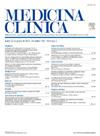乳房切除术对重症肌无力发展的影响:分析21例患者
IF 2.1
4区 医学
Q1 MEDICINE, GENERAL & INTERNAL
引用次数: 0
摘要
重症肌无力是一组神经肌肉连接障碍的一部分。胸腺切除术已被证明是有效的临床控制。本研究的目的是评估胸腺切除术治疗重症肌无力儿童的有效性和安全性。方法对21例重症肌无力患者行胸腺切除术后随访1年的临床资料进行分析、回顾性、纵向研究。评估的变量包括重症肌无力的日常生活活动评分、吡哆斯的明剂量、皮质类固醇剂量以及手术前和手术后一年的重症肌无力加重情况。结果12个月时患者日常生活活动评分明显改善(p = 0.002)。术后3个月内危象减少;这一趋势在12个月时保持不变(p = 0.0003)。然而,12个月时吡啶斯的明(p = 0.147)和皮质类固醇治疗(p = 0.11)的减少没有达到统计学意义。结论胸腺切除术具有一定的疗效,包括重症肌无力日常生活活动量表得分的提高和重症肌无力加重/危象发生频率的降低。这些发现表明胸腺切除术是一个安全有效的选择,可以考虑对一线治疗没有反应的儿童患者。本文章由计算机程序翻译,如有差异,请以英文原文为准。
Efectividad de la timectomía en la evolución de la miastenia gravis: análisis de 21 pacientes
Introduction
Myasthenia gravis is part of a group of neuromuscular junction disorders. Thymectomy has been shown to be effective for its clinical control. The aim of this study was to assess the usefulness and safety of thymectomy in children with myasthenia gravis.
Methods
An analytical, retrospective, longitudinal study was conducted by reviewing the medical records of 21 patients with myasthenia gravis who underwent thymectomy and were followed-up for one year post-surgery. The variables assessed included the Myasthenia Gravis Activities of Daily Living score, pyridostigmine dose, corticosteroid dose, and myasthenia gravis exacerbations immediately before and up to one year after the surgery.
Results
The activities of daily living score significantly improved at 12 months (p = 0.002). Crises decreased within 3 months post-surgery; this trend was maintained at 12 months (p = 0.0003). However, the reductions in pyridostigmine (p = 0.147) and corticosteroid therapy (p = 0.11) at 12 months did not reach statistical significance.
Conclusions
Thymectomy showed benefits, including improved scores on the Myasthenia Gravis Activities of Daily Living Scale and a reduction in the frequency of myasthenia gravis exacerbations/crises. These findings show that thymectomy is a safe and valid option to consider for pediatric patients who have not responded to the first-line treatment.
求助全文
通过发布文献求助,成功后即可免费获取论文全文。
去求助
来源期刊

Medicina Clinica
医学-医学:内科
CiteScore
3.10
自引率
5.10%
发文量
295
审稿时长
22 days
期刊介绍:
Medicina Clínica, fundada en 1943, es una publicación quincenal dedicada a la promoción de la investigación y de la práctica clínica entre los especialistas de la medicina interna, así como otras especialidades. Son características fundamentales de esta publicación el rigor científico y metodológico de sus artículos, la actualidad de los temas y, sobre todo, su sentido práctico, buscando siempre que la información sea de la mayor utilidad en la práctica clínica.
 求助内容:
求助内容: 应助结果提醒方式:
应助结果提醒方式:


